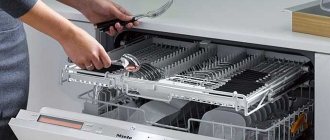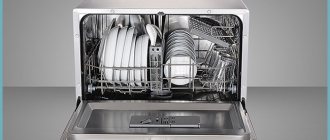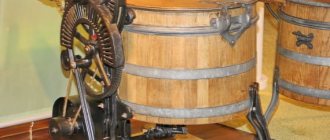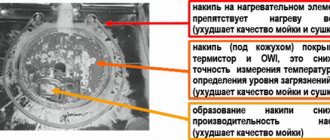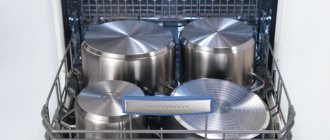Residents of European countries have long been unable to imagine life without a dishwasher. In Russia, such a miracle of technology has not yet become an integral part of every family’s life, but the number of people who appreciate the benefits of machine washing is constantly increasing. The invention of a useful device has its own interesting history. So who came up with it?
- Who invented the dishwasher
- The principle of washing in PMM
- Advantages
- Flaws
- Dishwasher catalog with reviews
A little history of the first attempts
So, let's delve into history to find out who invented the dishwasher. Find out to whom we should be obliged for the opportunity to spend the most valuable minutes of our lives on family and loved ones, on learning new things, or just having a pleasant rest instead of cleaning the dishes.
There were attempts to invent the first dishwashing machine back in 1850. But they came to nothing. Joel Houghton is the one who invented the dishwasher in its original form. But he did not achieve much results - his device was absolutely inconvenient and ineffective, since there were a lot of shortcomings.
However, humanity did not stop there and now it has happened! The first dishwasher appeared.
Failed Attempts
Joel Goughton is an American who received patent No. 7365 in 1850, which recorded the authorship of “an improvement for a dishwashing machine.” Before Goughton, various people made unsuccessful attempts, their names have been lost.
The device created by Goughton was a rather strange and inconvenient design:
- The base is a cylindrical container equipped with a vertical shaft through which heated water is supplied.
- Those who wanted to use the device had to work with their hands: they had to turn the handle so that the buckets would take in water, pour it out, take it in again - and so on in a circle.
Goughton's machine made it possible not to get your hands wet in water. The device was a failure and had no economic prospects - this is just an unsuccessful touch on the way to creating a real dishwasher (PMM). The unsuccessful design would have sunk into oblivion if it had not been preserved in the archives of the US Patent Office.
Madame Josephine Cochrane and her initial developments
So who invented the dishwasher in a more convenient version? We have Madame Josephine Cochrane to thank for this. It should be noted that she was a rich lady and, of course, she herself did not do such not particularly pleasant work as washing dishes. This was done by her servant. But, to put it mildly, the hostess did not like the efficiency and neatness of the servants. Quite often, some part of her beautiful china services would break, which caused Madame Cochrane bitterness and disappointment.
She tried to solve this problem for a long time, even tried to start washing the dishes herself, but this was not a solution - after all, a rich lady should not do such things. As a result, madam, who knows the basics of physics and mechanics thanks to her upbringing in the family of an inventor, through long calculations and theories was able to create a drawing of Josephine Cochrane's dishwasher.
Madame patented her invention on December 31, 1885 at the US Patent Office. Accordingly, this is the time that is considered to be the year of the invention of the dishwasher. The following year, the first sample was collected. This machine was a wooden basket with an axle in the center. The basket contained various racks on which dishes could be placed. This axis had to be untwisted by the housewife or dishwasher. In this way, the necessary cleaning of the dishes took place.
This dishwasher was a huge success - all hotels, restaurants and other public institutions were eager to purchase such devices. Madame Cochrane received a flood of orders, and she founded her own company producing “Cochrane sinks.” But it was still a manual dishwasher - in the washing process it was still necessary to use, albeit to a lesser extent, manual labor.
Josephine's first clients were not housewives
The dishwasher was too expensive for them. Josephine turned to hotels. The Palmer House Hotel in Chicago was the first to buy a typewriter. Then she decided to do the worst thing for her - she came to the Sherman House Hotel. She admitted to reporters:
“You asked me what the hardest part of the business was... I think it was when I crossed the hall of the Sherman House alone. You can't imagine what it looked like at that time... a woman walking through the hotel lobby alone. I had never been anywhere without my husband or father—the hall seemed a mile wide. I thought at every step that I would faint, but no - and I received an order for $800 as a reward for this.”
“You asked me what was the hardest part of getting into business... I think, crossing the great lobby of the Sherman House alone. You cannot imagine what it was like in those days… for a woman to cross a hotel lobby alone. I had never been anywhere without my husband or father—the lobby seemed a mile wide. I thought I should faint at every step, but I didn’t—and I got an $800 order as my reward.”
In 1893, Josephine convinced restaurants at the World's Columbian Exposition in Chicago to use her invention. This success led to her opening her own factory in an abandoned school building. Her clients were hospitals and colleges for which disinfection was of great importance. Housewives have finally started using machines too.
Woman using Cochrane dishwasher
In 1912, when she was 73, Josephine was still selling her cars personally. She died in 1913. And in 1916, her company was bought out by KitchenAid, which is now Whirlpool Corporation.
Improving the unit
But Josephine Cochrane didn’t stop there. A necessary step was the invention of an automated version of the dishwasher. The original design was improved upon and the new version of the dishwasher added a steam engine that rotated the grates and supplied hot water. This model of dishwasher was patented in 1900. But even with this, the one who invented the dishwasher in its original form did not complete its scientific developments and the introduction of innovations. So, the next stage of product modernization was replacing the movement of the racks inside the machine with rotational ones and adding the ability to pump used water into the sink.
Path to the masses
The next stage in the production of dishwashers was the production of smaller units for the home kitchen. However, it was not long before ordinary housewives decided to buy such an assistant for their home, because the price was quite high. But with the spread of information that using this wonderful unit kills all germs in very hot water, sales for personal use began to increase and the automated dishwasher gained enormous popularity throughout the world.
This is the story of the dishwasher, the creation of which changed many things in the past, present and future life of mankind. The story is unique, because the discovery might well not have happened if the sets had remained completely intact and clean. We found out who invented the dishwasher, the development of which led to the further development and production of ever newer models with different functions.
It is better to connect the dishwasher to cold water
Modern machines are connected to both cold and hot water. But the best option is to connect it to cold water. This is due to the fact that cold tap water is usually cleaner than hot water. Although there is a disadvantage of such a connection - the machine will consume more electricity, since the water will need to be heated before being supplied to the sink. Another important factor is periodic shutdowns of hot water. After all, when connecting the machine to hot water, when the water is turned off, you will have to wash the dishes manually, and with cold water.
Variety of shapes and sizes
Nowadays, a dishwasher is not a luxury item. Almost every family has such equipment. Thanks to it, for dazzling cleanliness, you only need to load the plates and glasses into the machine, add a cleaning solution, a little time and “voila” - the dishes are sparkling! In addition, when using such a machine, not only time is saved, but also the most precious resource - water, which is already quite scarce in many areas.
Nowadays there are dishwashers of both industrial sizes and modest ones for the smallest kitchen, there are very expensive appliances, and there are budget ones: choose exactly the option that your family will like.
Dishwashers in the USSR
In the USSR, household dishwashers were not produced. But special units were produced for catering, schools, hospitals and other public institutions. The main manufacturer of such devices was considered to be the Trade Mechanical Engineering Plant in Grodno (Belarus). The company is still operating today. The latest models produced at this plant have a production capacity of up to 2800 items per hour. The price of Belarusian industrial PMMs is up to 100,000 rubles, which is half the price of Western brands.
Types of modern dishwashers
On the modern market of dishwashers, you can find three possible types - built-in, stationary/partially built-in, or portable/desktop.
Let's look at each in more detail.
- Built-in dishwashers are an ideal option if you are planning to equip a kitchen from scratch, that is, you have the opportunity to allocate space for the machine when designing a kitchen unit. In addition, this is the best option for the design of the future premises - nothing will stand out too much when viewed. With this option, the dishwasher is completely built into the unit and only the control panel will be visible.
- Stationary/partially built-in dishwashers are an option for those who already have a kitchen equipped and want to purchase a machine. In this case, the unit will be installed partially in the set and not under a common countertop or facade. Also, such a machine can be installed separately where possible. Of course, with this option there is no longer a general concept for kitchen design, since the machine will already be visible and you will have to choose specifically according to predetermined dimensions, but you will have the opportunity to use such a wonderful invention! The control panel of such a machine is already on the door and, if necessary, you no longer have to open the filled machine in order to turn it on for a work cycle. Agree, this is a big plus.
- Portable/countertop dishwashers - these babies will be a real salvation for those who have absolutely nowhere to put the two previous options. This machine can be installed on a kitchen countertop due to its modest size. Connecting it is quite simple - you just need access to the faucet and sink. But, of course, you can’t load a lot of dishes into such a machine - this is its disadvantage.
Dishwasher operating diagram
Modern PMM is a complex device. To understand the functional significance of its components, you should consider step by step the principle of operation of the device.
So, while washing dishes in a dishwasher, the following processes occur.
- The dishes are loaded, the required washing mode is selected and the machine starts.
- The inlet valve opens, water begins to fill, and the heater turns on.
- When the pressure switch is activated, the inlet valve closes.
- Detergent and salt are added to the water, although the latter can be constantly in the flow compartment.
- The circular pump turns on, and water begins to flow under pressure from the holes of the nozzles, spinning them.
- After draining and filtering, the water again enters the pump through a container with salt.
- After the washing cycle is completed, dirty water is pumped into the sewer, and clean and cold water is collected instead. The first rinse cycle begins.
- After the first rinse is completed, the liquid is drained by the pump and new water is drawn in. It heats up and then rinse aid is added to it. The second rinse cycle begins.
- After the second rinse is completed, the water is drained into the drain and the drying process begins.
Drying the dishes ends the dishwasher's operating cycle.
The function of a drain pump can also be performed by a circulation pump. This design reduces the number of mechanisms and improves the reliability of the dishwasher.
To ensure high-quality washing, it is advisable to wipe the dishes from large pieces of food before placing them in the PMM. Then all the dirt will be washed away after the washing stage and will not get on the products during the rinsing period.
Criteria for choosing dishwashers
Definitely, before choosing one or another model of equipment, you need to find out the following nuances:
- Dimensions: the choice depends on the area of the kitchen and the size of the space that will be allocated for installing the dishwasher.
- Type of dishwasher itself (built-in, stationary/partially built-in or portable/desktop).
- The price you are willing to pay for a new kitchen assistant.
- The capacity of the dishwasher is one of the most important criteria. Different models can accommodate from 4 to 17 place settings. On average, according to statistics, the machine is turned on once a day, so before purchasing, you need to decide how many sets of dishes your family will accumulate for breakfast, lunch and dinner. Additionally, you can add space for several pots or pans.
- The efficiency of the dishwasher: you need to find out how much water and electricity will be consumed during 1 cycle of operation. In addition, you need to pay attention to consumption both in economy mode and in normal mode.
- Number of functions performed - mainly about five programs are used - normal, intensive, economical, fast, with pre-soaking, mode for washing fragile dishes. Not superfluous functions will include a half-load mode, sterilization, timer delay, and child protection.
First dishwasher
Facts about early dishwashing aids vary depending on the source. They write that the first developments belonged to the Romans, but to our time neither verbal descriptions nor illustrations of the “great-grandmother” of the modern PMM have survived. Therefore, the name of the genius who actually decided to wash dishes for the first time without his own hands will remain a mystery of past centuries.
A documented design appeared in 1850. The world of science learned for the first time about a unit capable of washing dishes, excluding hand contact with water and dishes. A young resident of the United States, Joel Goughton, patented the development, presenting a failed design that had no prospects in economic terms.
Interesting! A striking example of when a good idea suffers from stupid implementation of the project. There was only one PMM prototype from Goughton, and during the first test the imperfection of his “brainchild” became obvious.
Around this time, King invented the first washing machine, so these two household appliances to this day go “hand in hand” in the home and household appliances market. This does not speak in favor of a dishwasher, because every family in Russia is familiar with a washing machine, which cannot be said about a dishwasher.
Why did Goughton fail?
He came up with a design powered by hands. This machine had a tank, a piston pump that supplied water, and an overly complex and bulky frame on which the tank and drive handle were held. The advantage over manual washing was in the idea itself - Goughton gave housewives the hope that they would soon be able to automate the washing process. The dishwasher had more disadvantages: poor quality of washing, putting dishes in the tank left much to be desired - there were a lot of broken plates afterwards, and some of the utensils were not washed due to improper water supply. The design did not have a system for pumping out dirty water, and rinsing took place in waste dirty slurry.
Types of detergents
The use of detergents is mandatory for operating the dishwasher. Currently, there are a lot of such helpers: powders, gels, tablets, universal 3in1 products - as they say, for every taste, color and budget. In addition, you need to use a water softener, rinse aid, and freshener. When using such products, the dishes will shine clean and fresh!
Advantages
- Since a person does not touch the dishes during washing, very strong detergents can be used for them, which are dangerous for the skin when washed by hand.
- For the same reason, it is possible to wash and rinse dishes at high water temperatures (≈55–65 °C)
- Water consumption is lower compared to manual washing (9[7] - 20[8] liters versus 60 liters[9] for 12 sets[10] of dishes). Savings are achieved by reusing the same water at each washing stage.
- Hot water supply is not required.
- A wide range of detergents and abrasives, sponges, brushes and the like are not required. All you need is a special salt to soften the water and one type of detergent.
- The role of a person in washing dishes comes down to loading dirty dishes into the machine and unloading clean ones. The process itself does not require participation or supervision and can occur at any time.
Problems during operation
So, you have acquired a wonderful assistant for your kitchen. What problems may arise during operation in which you will have to repair dishwashers on your own:
- There is extraneous noise when the machine is operating: in this case, either the dishes are poorly secured, or the bearings are damaged and will have to be replaced.
- The dishwasher does not turn on: check the power supply, close the door tightly, check the water supply, or the blown fuse needs to be replaced.
- The machine turned off without completing the operating cycle - you need to check the power supply, check the functionality of the fuse, or you will have to change the working pump.
- Long-term filling with water: check the water supply pressure or clean the inlet pipes.
- The loading compartment door does not close - check the machine’s balancing and other things.
In case of more serious breakdowns of home or industrial units, it is better to entrust the repair of dishwashers to professional service workers.
Principle of operation
The dishwasher ensures impeccable cleanliness of dishes and kitchen utensils due to the fact that the heating temperature of the water in the machine reaches 60 degrees, which means that the active components of detergents cope more effectively with any type of dirt.
In addition, this technique additionally dries the dishes, preventing the appearance of streaks and water stains on them.
Complete removal of dirt and grease from kitchen utensils is carried out using a water jet supplied from the machine’s rocker arm at speeds of up to 150–160 km/h. Dirty wastewater is discharged into the lower compartment for thorough filtration and recirculation.
Expensive models are equipped with special filters in which cleaning is performed automatically, and accumulated dirt is removed through a drain pump into the sewer.
Automatic intake of the required volume of water is carried out by a built-in pump through a bypass valve, which is located at the point where the hose connects to the body of the device.
There is also a standard filter - a mesh, which is designed to retain large pieces of debris. The central pump supplies water through a pipe to the rocker arms.

